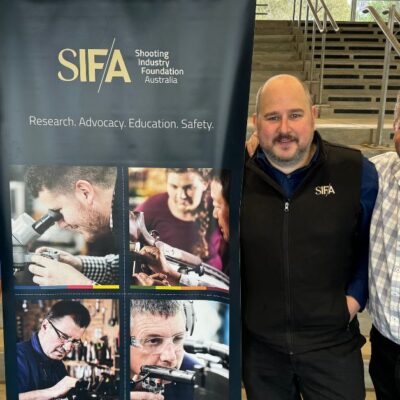SIFA urges caution at fresh calls for a national firearms register.
SIFA Statement – National Firearms Register
On the 3rd of February 2023, the Prime Minister announced that National Cabinet had agreed principles for a nationally coordinated approach to the management of firearms, and tasked Police Ministers to report back to National Cabinet in mid-2023 with options to implement a National Firearms Register.
SIFA is extremely concerned that these calls will undermine Australia’s current firearms registry systems that have been supported by the Australian shooting industry, and that have already attracted heavy taxpayer funded investment by governments.
In Australia, the registration of firearms is the responsibility of the state and territory jurisdictions, with the tracking of interstate firearm movements achieved via a federal government funded system managed by the Australian Criminal Intelligence Commission known as AFIN (Australian Firearms Information Network).
The Australian shooting industry, through years of engagement and consultation has embraced the current systems and highlighted that attempts to improve the operation and accuracy of this system have been hampered by governments failing to properly fund commitments to improve their operation.
Sharing of firearms data is only effective where state and territory registries have accurate and timely data available to share. Governments have admitted that the accuracy of the firearms data they hold currently varies, and this is directly linked to the resources they have available and the need for further government funding.
Australia does not need a National Firearms Register. Australian governments have already spent tens of millions of dollars in developing jurisdictional firearms registries and having these systems integrated federally with the AFIN.
What the federal government is calling for already exists. All Australian governments MUST commit to properly funding the AFIN and existing state and territory firearms registries, in order to ensure they have the necessary staff and resources available to boost their capabilities, increase data accuracy and service levels, while ensuring the timely collection, input and processing of firearms data. This will also ensure that Australia’s strong and robust firearms laws continues to function as originally intended and uphold public safety.
SIFA’s position is that the current state and territory based firearms registries that utilise a common data sharing interface (AFIN) is maintained; and we call on the federal, state and territory governments to properly fund these systems to allow their efficient operation as designed.
SIFA has attempted to address our concerns with the Government on behalf of the Australian shooting industry, and at this stage we have been largely ignored and told that consultation will happen at a later stage.
Given that SIFA has been at the forefront of discussions around the design and implementation of the current systems by which our industry functions, SIFA also calls on the Federal Government to re-establish the Commonwealth Firearms Advisory Council and initiate immediate consultation with the Australian shooting industry.
Background.
- Under the Australian Constitution, the states and territories have primary responsibility for the management of firearms in Australia. Each State and Territory in Australia records and tracks the sale and movement of firearms, and individual firearm licence details. The Commonwealth has responsibility for international and inter-state trafficking offences and the import and the export of firearms and firearm-related articles. [i]
- The National Firearms Agreement (NFA), first negotiated in 1996 and subsequently updated in 2017, is a non-binding inter-governmental agreement, which has formed the basis of our jurisdiction firearms laws.[ii]
- The Firearms and Weapons Policy Working Group (FWPWG) was created in 2001 and meets quarterly and brings together firearm registry managers and policy representatives from all jurisdictions and is responsible for delivering national consistency in firearm regulation. [iii]
- In 2012, the states and territories reached an agreement with the federal government with regards to further firearms reforms. These were aimed at targeting the illicit firearms market and included (amongst other things) establishing a National Firearms Interface (NFI). [iv]
- In 2013, the Abbott government abolished the Commonwealth Firearms Advisory Council. This had the effect of depriving law makers of expert industry advice and real-world feedback on what was not working with the current arrangements. [v]
- In 2015, the Law Crime and Community Safety council announced the development of the National Firearms Interface (NFI). The purpose of the NFI was a national database to provide a single shared record for each firearm in Australia and is reported to have an ability to trace firearms from ‘foundry to furnace’. [vi]
- Following the Lindt Café siege in 2015, the Commonwealth and NSW Governments released a joint review that recommended:
– 7. CrimTrac, in cooperation with Commonwealth and State Police and law enforcement agencies, should prioritise bringing the National Firearms Interface into operation by the end of 2015.
– 8. States and Territories’ police forces should conduct an urgent audit of their firearms data holdings before the National Firearms Interface is operational where this has not already occurred.[vii] - Following the recommendations, the Abbott government announced that the National Firearm Interface would be fast tracked to be completed by the end of 2015.[viii]
- In 2017, the Coronial inquest into the deaths arising from the Lindt café siege recommended that “the Commonwealth, states and territories simplify the regulation of the legal firearms market” and that “state and territory police forces should conduct an urgent audit of their firearms data holdings before the National Firearms Interface is operational”. [ix]
- At the November 2019 meeting of the Ministerial Council for Police and Emergency Management, Ministers agreed to take a coordinated approach to address firearms registry issues.[x]
- The Australian Firearms Information Network (AFIN) replaced the NFI in 2019 and provides “a national view of information available about each firearm in Australia known to police and law enforcement agencies, improving and enhancing the current information available to support law enforcement agencies and the officers who protect our communities”. [xi]
- When presenting to the Legal and Constitutional Affairs Committee on 22nd March 2021, on the purpose of the AFIN, the CEO of the ACIC Michael Phelan advised “it’s an information exchange system when it comes to AFIN. For example, the information is vested and held in each of the jurisdictions in their relevant firearms registries, and the idea of AFIN is to pull all that material together so others can have access so that we can have that cradle-to-grave initiative”. [xii]
- In 2021 an additional $8.65 million was made available from the ACIC special account for states and territories to fully integrate their registries with AFIN. This is on top of the initial funding to develop AFIN. [xiii]
- Publicly available data by respected bodies such as the NSW Bureau of Crime Statistics and Research (BOCSAR) confirms that firearm related injuries and homicides continue a long-term downward trend. [xiv]
References.
[i] https://www.homeaffairs.gov.au/criminal-justice/files/commonwealth-firearms-information-booklet.pdf
[ii] https://www.ag.gov.au/crime/publications/2017-national-firearms-agreement
[iii] https://www.directory.gov.au/portfolios/home-affairs/firearms-and-weapons-policy-working-group
[iv]https://www.aph.gov.au/Parliamentary_Business/Committees/Senate/Legal_and_Constitutional_Affairs/Illicit_firearms/Report/c01
[v] https://australianpolitics.com/2013/11/08/abbott-abolishes-advisory-bodies.html
[vi] https://www.smh.com.au/national/firearms-database-aims-to-stop-gun-trafficking-20150521-gh6vu8.html
[vii] https://www.homeaffairs.gov.au/nat-security/files/martin-place-siege-nsw-review.pdf
[viii] https://www.theage.com.au/national/firearms-database-aims-to-stop-gun-trafficking-20150521-gh6vu8.html
[ix] https://www.lindtinquest.justice.nsw.gov.au/Documents/findings-and-recommendations.pdf
[x] https://www.homeaffairs.gov.au/how-to-engage-us-subsite/files/mcpem-communique-20112019.pdf
[xi] https://www.acic.gov.au/services/firearm-services
[xii]https://www.aph.gov.au/Parliamentary_Business/Hansard/Hansard_Display?bid=committees/estimate/567ff01c-d590-41e8-ab09-bd5d4e996f13/&sid=0004
[xiii]https://www.aph.gov.au/Parliamentary_Business/Hansard/Hansard_Display?bid=committees/estimate/5a04d4d3-dbab-4c85-8b2b-7dbb472ed9d7/&sid=0006
[xiv]https://www.bocsar.nsw.gov.au/Pages/bocsar_pages/Violent%20Crime.aspx













